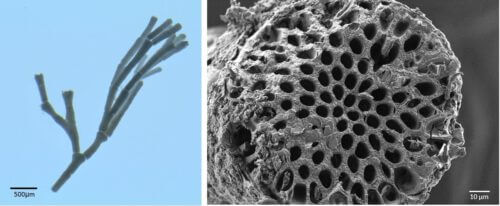Researchers at the Technion deciphered the unique structure that gives red algae its resistance to strong currents in the sea. The analysis of the structure was conducted at the large particle accelerator in Grenoble

Researchers at the Technion deciphered the unique structure of the algae Jania sp. The research published in the journal Advanced Science was led by Prof. Beaz Pokroy and PhD student Nofer Bianko-Stein from the Faculty of Materials Science and Engineering. The algae Jania sp, from the red algae family (phylum Rhodophyta), is widespread in shallow waters, where it is subject to hostile conditions including humidity, salinity and strong currents. Its durability is based on a unique micrometric structure that combines great flexibility with strength. The Technion researchers were looking for the recipe for this combination in the current study.
To trace the algae's unique microstructure, Technion researchers examined it at the ESRF synchrotron in Grenoble, France. This circular particle accelerator, with a circumference of 844 meters, is the most powerful synchrotron in the world in terms of the intensity of the light it produces; The X-rays it produces are 100 billion times stronger than a hospital x-ray machine. The researchers examined the acceleration in three beamlines at the synchrotron, and then integrated the findings.
Many of Prof. Pokroy's researches in recent years deal with biomineralization - a process in which living beings create minerals. Through controlled biomineralization, these animals create complex structures that they use for their needs. The current research focuses on the biomineralization of calcite in algae. Calcite, which is a very stable version of calcium carbonate, is a very common component in the skeletal parts of many sea creatures and it gives them their hardness. Man knows how to produce artificial calcite, but the calcite produced in nature is characterized by complex and unique shapes that give it high durability and other unique properties. In a previous study, Pokroy showed that such formations are formed in the transition from an amorphous phase to a crystalline phase. This is how, for example, the sea urchin builds its skeleton. The building of the crystals through the amorphous phase allows the assimilation of many nanometer magnesium particles in the calcite, thus creating magnesium-enriched calcite.
In the current study, Prof. Pokroy discovered that the skeleton of the red algae Jania sp also contains magnesium-enriched calcite, and here too it is the formation of the embryo in an amorphous phase. In this process a very porous texture is created; In fact, volumetrically, this algae contains more air than solid material - its pore volume occupies about 64% of its total volume.
An equally important finding is the helical nature of these pores - a unique characteristic that gives algae that rare combination of flexibility and durability. "This helical shape," says Prof. Pokroy, "increases the resistance of acceleration by bending forces by about 20%. We hope that based on these findings, innovative methods will be developed to produce artificial materials with similar characteristics - helical pores - that will be light, flexible and strong like the skeleton of Jania sp, which developed over hundreds of millions of years of evolution."
Prof. Boaz Pokroy is a member of the scientific committee of ESUO - the European organization of synchrotron users - and he emphasizes that the current research is based on many years of cooperation with the synchrotron in Grenoble.
The study was supported by the European Research Commission with the ERC grant - Seventh Framework Program FP/2013-2018.
More of the topic in Hayadan:

One response
A little scientific editing wouldn't hurt
… awkward to read